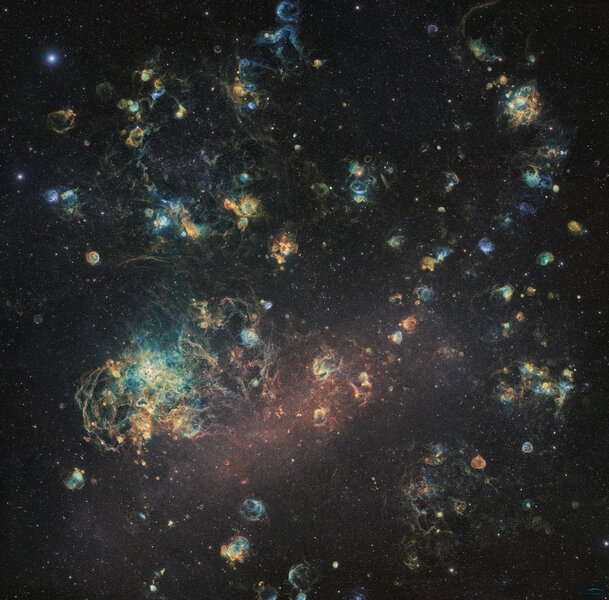Create a free profile to get unlimited access to exclusive videos, sweepstakes, and more!
'Amateur' astronomers create an incredible 1000+ hour image of a galactic neighbor

It's hard to draw a bright line between the status of an "amateur" astronomer and a "professional" one. When I was a kid it was somewhat easier, at least in vernacular; a professional was paid to do astronomy as a career, whereas an amateur did it for the fun, the joy, and not for pay.
But that's not a great distinction, and — as so often happens, especially in astronomy it seems — trying to define something gets pretty tough near the edges. For every definition you can come up with, I can usually come up with a counterexample.
This task is near impossible now anyway. The astonishing quality of "amateur" imaging not only rivals what can be done by professionals in many ways, it easily surpasses what pros were doing just a few years ago.
I mean, c'mon, evidence abounds, but here's the latest mind-blowing proof: A stunning image of the Large Magellanic Cloud (or LMC), a dwarf companion galaxy to the Milky Way.
Ye. GADS.
The LMC is 10° across in the sky, which is huge (20 times the width of the Moon), so it may not surprise you to find out this is a mosaic of 16 subfields, stitched together seamlessly to produce the final image. It was taken at the El Sauce Observatory in Chile, by five "amateurs" — Jean Claude Canonne, Philippe Bernhard, Didier Chaplain, Nicolas Outters, and Laurent Bourgon — who used their own (very nice) TEC 160 mm telescope hosted there. The skies in this location are very dark, so deep images like this become possible.
And by deep, I mean deep. This image is comprised of a staggering 1,060 total hours of observing taken between April 2017 and January 2019. And the original is huger than huge: It's a 200+ megapixel image weighing in at over 100 megabytes. The amount of processing it took to create this must have been enormous. They did a phenomenal job, too.
They used an interesting combination of filters. One top of the usual red, green, and blue (plus one unfiltered exposure, called a luminance frame, to get brightness information without color), they also used three filters that look at very narrowly selected colors to highlight the light emitted from hydrogen (displayed as red), oxygen (blue), and sulfur (also shown in red). That brings out the gas in space between the stars.
And the LMC is positively littered with gas clouds, some of which are actively forming stars, and some of which are leftover from stars that have since exploded. Usually, images of the LMC don't highlight these, but the narrow filters make them pop right out, showing just how many of them this diminutive galaxy has.
Some of them I recognize, like the famous Tarantula Nebula, which is one of the largest nebulae in the entire Local Group of dozens of galaxies to which the LMC (and the Milky Way belong):
Yikes. This nebula is so big and creating so many stars that astronomers think it may be in the process of birthing a globular cluster, a huge collection of hundreds of thousands of stars. Back in 1987 a massive star born in the outskirts of the nebula exploded, creating Supernova 1987A, so yeah, there's a lot going on here.
I scanned around the original image, and I have to admit I quickly got lost. Besides being an unusual filter combination highlighting nebulae, there's just so much stuff floating around the LMC that I lost my bearings rapidly. Wikipedia has an annotated (and rotated) image of the LMC that helps, but only some. The image here is so deep a lot of the features aren't on that map.
And I just kept finding so many interesting bits; assorted globular clusters, supernova remnants, stellar nurseries… look, here's a section that has a little bit of everything:
That gigantic cloud is called N11, or the Bean Nebula, and is second in size only to the Tarantula in the LMC. It's something like 1,000 light years across in total (!!) to give you a sense of scale. The trained eye can see it's busily churning away making stars; it has several cavities inside it created when the light and winds from ridiculously massive stars carves out blisters in the gas. Some of them are filled with bluish gas which is oxygen excited like it's inside a neon sign, energized by the fierce light of those massive stars.
There are several globular clusters in that frame, including NGC 1783 above center, and NGC 1818 to the left.
I could go on and on, but instead I'll let you explore; use that Wikipedia image as a guide.
But I hope you now see what I mean. If a team of "professional" astronomers made this image I would be very impressed, but the fact that it was made with a single small telescope by fiercely dedicated "amateurs" only makes it sweeter.
And it seriously blurs the line between them even more. I try not to get too hung up on labels, especially when they confuse the issue of classification, or perhaps more importantly make distinctions that aren't terribly important. In this case, I think labeling the team does both. So you know what? I think I'll just call them astronomers. Because that they most definitely are.





























